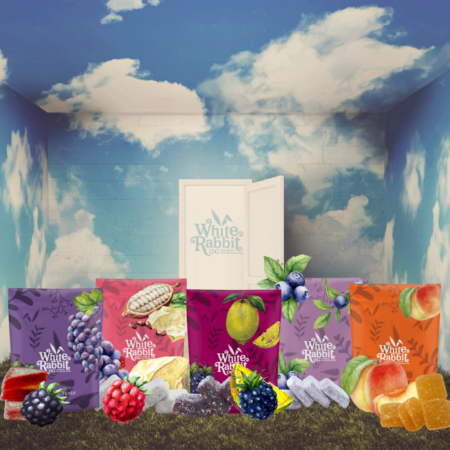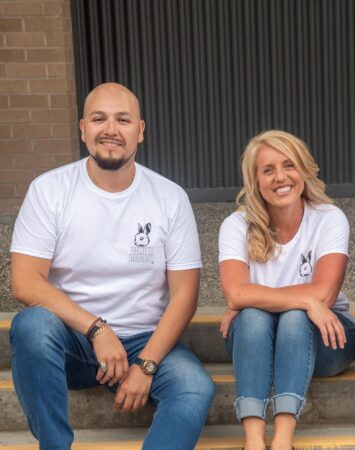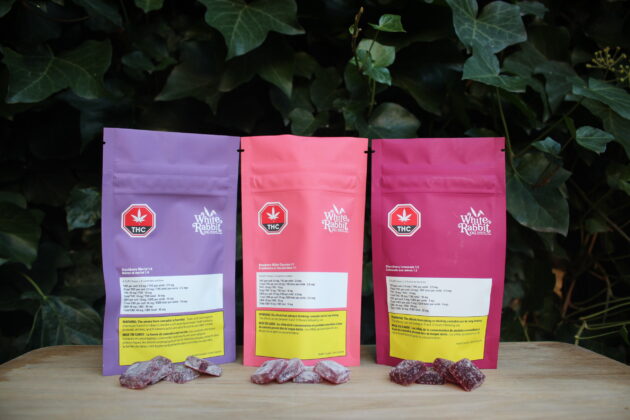
White Rabbit creates a niche with edibles
By Nithya Caleb
Products British Columbia cannabis edibles White Rabbit OGWhite Rabbit OG edibles are made with whole fruit puree, organic and gluten-free sugars, and cannabis.
 White Rabbit OG edibles are made with whole fruit puree, organic and gluten-free sugars, and cannabis. All photos courtesy White Rabbit OG
White Rabbit OG edibles are made with whole fruit puree, organic and gluten-free sugars, and cannabis. All photos courtesy White Rabbit OG Many CPG companies begin when their founders are inspired by a grand vision and motivated enough to turn their basement or garages into experimental kitchens. A similar thing happened at White Rabbit OG, a South Surrey, B.C. -based cannabis edibles company.
After years of working in the food manufacturing and cannabis sectors, Kyrsten Dewinetz, co-founder and CEO, and David Lluncor, co-founder and chief revenue officer, realized that “people were almost looking [to recreate] the past versus looking to the future.”
In January 2020, the duo decided to start White Rabbit Naturals, the parent company of White Rabbit OG, to create a portfolio that would deliver on key fundamentals customers were looking for in the cannabis edibles market—products with unique flavour combinations and whole fruits. Dewinetz’s basement became their office and formulations lab.
Talk about timing! The pandemic made for a rocky start. White Rabbit isn’t a licensed producer. “The ability to seek out a partner with the appropriate licensing and facilities was greatly hampered by COVID-19, as a lot of people didn’t want to open their doors to strangers at that time,” explained Lluncor. They have now managed to find a licensed facility in Delta, B.C.
Lluncor and Dewinetz firmly believe cannabis edibles is a growing category. Consumers who are interested in trying cannabis and are hesitant to smoke it would prefer to experiment with edibles. Currently, the maximum THC dose in a pack of edibles in Canada is 10 mg and 100 mg in the U.S. Companies like White Rabbit OG would experience more growth when Canadian regulatory limits ease. Also, as more countries legalize recreational marijuana, business opportunities would also increase for White Rabbit OG.

David Lluncor and Kyrsten Dewinetz
Products
White Rabbit OG edibles are made with whole fruit puree, organic and gluten-free sugars, and cannabis in small batches. The chewables are vegan, plant-based, gelatin- and gluten-free with no artificial flavours or colours. Flavours include Craft Blueberry, Craft Sour Peach, Blackberry Lemonade, Raspberry White Chocolate, Blackberry Merlot, and Strawberry Fig Balsamic CBD.
“We’re really looking to create fusion and excitement for the customer. The Raspberry White Chocolate chewable was inspired by white chocolate cheesecake with raspberry coulis. The Blackberry Merlot is a take on the wine and the Blackberry Lemonade is like a cocktail,” explained Dewinetz. “Our competitors are primarily using gelatin, artificial colours and flavours. Customers can expect from us a fruit offering using real fruit ingredients.”
The soft chews are available in recreational cannabis stores in British Columbia, Alberta, Saskatchewan, and Ontario, and on Medical Cannabis by Shoppers Drugmart.
The edibles are powered by Eat Me Technology, a proprietary cannabis emulsion made using plant-based extracts like Quillaja and sunflower oil.

The flavour combinations in White Rabbit OG’s products are rare in the edibles market.
Eat Me Technology
Since Cannabis distillate is fat-soluble, it is difficult to evenly distribute into edibles products. By using an emulsifier, White Rabbit OG’s proprietary technology homogenizes the cannabinoids into a uniform mixture, which allows for an even distribution. This means the dosing is consistent throughout the product.
“The Eat Me Technology was developed to create operational efficiencies and to comply with regulations for potency. It was also created with specific ingredients and particle size to ensure there was better bio availability,” explained Dewinetz. “One of the challenges with edibles is that when you’re ingesting cannabis, the effects on the body are much lower than when inhaling it. Typically, edibles can take an hour-and-a-half to two hours to take full effect, and that can be a little bit dangerous. It can lead to overconsumption because people want instant gratification. By reducing particle size, you’re increasing the bio availability. You see a faster onset time and it’s a little easier to dose appropriately. It also makes the experience more predictable each time.”
Challenges
Being a small firm, the founders have bootstrapped everything. They were managing the entire business and were up against large corporations with endless amount of funds for marketing. It was difficult to gain a presence in the marketplace. “We really had to dig deep to push through and persevere through the challenges we were facing,” said Lluncor.
Further, White Rabbit OG uses premium ingredients. The heat waves and floods in 2021 made it hard for them to procure fruits. Supply chain has been challenging for the founders. “We’re trying to find alternative suppliers for some of the ingredients but because we have fairly unique ingredients it’s definitely becoming more and more tight. The lead times are longer. Most of the ingredients we use don’t typically have a long shelf life, so we’re trying to find that balance between having sufficient supply and using them before they expire,” said Dewinetz.
Future plans
When asked where they want to see White Rabbit OG in five years, the duo shared their desire to expand and introduce their technology and premium gummies to other countries. But first, the focus is on conquering their backyard.
Lluncor hopes that in the near future, cannabis edibles with CBD can be sold in grocery or wellness stores.
“CBD has a host of wellness to offer to customers that aren’t looking just to get high. We’re seeing a lot of neutraceuticals coming into everyday foods. Consumers are looking to enhance their health and address conditions by not taking a lot of pills and drugs. I’d love to see products with CBD and cannabinoids that don’t have psychotropic effects incorporated into the CPG channel,” shared Dewinetz. “Our hands are tied with what we can put into those gummies. Everything has to be specifically only for the function of the gummy. I can’t incorporate omegas or fibre just for health reasons. Gummy vitamins are a big part of many people’s lives nowadays. So, when they’re taking their all-in-one vitamin, I can’t really see CBD being very much different than adding a ginseng, ginkgo biloba or any other neutraceutical ingredient. I’d love to incorporate all of those” in the gummies.
This article was originally published in the August/September 2022 issue of Food in Canada.
Print this page